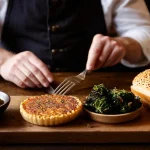Essential Techniques for a Juicy Pork Pie
Achieving a succulent pork pie hinges on masterful cooking techniques that preserve moisture throughout the process. Proper meat seasoning and marinating play crucial roles in enhancing flavor while keeping the filling juicy. Marinating the pork in a well-balanced mix of salt, spices, and sometimes liquid like stock or whiskey allows the meat to absorb flavor and retain its natural juices during cooking.
Temperature control during baking is another vital factor. Baking at a moderate, stable heat—typically around 160-180°C (320-356°F)—ensures the pork pie cooks evenly without drying out. High heat can toughen the meat, while low heat may lead to undercooking. Timing is equally significant; a precise bake time allows the fat in the meat to render slowly, basing the pork pie’s moist texture.
Also read : How can you bake a classic Cornish pasty at home?
Key steps to retain moisture include gently layering the meat, avoiding overpacking the filling, and preventing air pockets. These air gaps can cause dryness inside. By combining careful seasoning, controlled baking temperatures, and measured timing, you’ll consistently produce a moist pork pie with tender meat and rich, mouthwatering flavor.
Mastering Pork Pie Pastry
The foundation of a succulent pork pie often lies in the quality of its pork pie pastry. Selecting the right fats and flours is crucial to crafting a crust that complements the moist filling without overpowering it. Typically, a combination of hot water crust pastry using lard or butter results in a sturdy yet tender exterior.
Also to discover : What Are the Unique Flavors of Traditional British Cuisine?
Achieving a crisp, golden crust requires precise pastry preparation and temperature management. Overworking the dough can lead to a tough crust, while too little handling risks crumbling. Incorporating chilling periods during preparation relaxes gluten strands, resulting in a balanced texture that resists sogginess when baked with juicy meat.
Blind baking the pastry base is a valuable step to prevent the filling’s moisture from soaking through prematurely. This technique creates a sealed barrier that maintains crust integrity during baking. Additionally, sealing the edges thoroughly stops air and steam from escaping, preserving the juicy filling and ensuring the crust bakes evenly.
Understanding and applying these crust techniques supports producing a pork pie with both a flaky, golden shell and a delightfully moist pork pie interior—essential for a truly enjoyable eating experience.




